
Commercial real estate property insurance costs are on the rise. The average monthly cost of real estate investment insurance for a building in the United States reached $2,726 in 2023, up from $1,558 in 2013, according to the Deloitte Center for Financial Services.
And premiums are only set to increase. Deloitte projects the average monthly insurance cost for a commercial building could rise to $4,890 by 2030—that’s an increase of almost 80%.
Find out what’s driving these price increases and how commercial real estate investors can lower their insurance costs.
What’s driving up commercial real estate investment insurance costs?
Multiple factors contribute to the rise in insurance premiums for commercial real estate investors, including inflation, reinsurance market liquidity issues and regulatory constraints.
Our team can help you find the right payments and lending solutions for your business.
The primary cause, however, is the growing frequency and severity of natural disasters.
“Recent disasters—whether they be hurricanes, fires, storm surges—are unprecedented,” said Al Brooks, Vice Chair of Commercial Banking at J.P. Morgan. “And the losses suffered by the insurance industry are unprecedented.”
Severe weather impacts all asset classes across the country. California wildfires destroyed more than 18,000 structures in Los Angeles County alone in January 2025. The Midwest frequently sees polar vortexes, and a storm surge could leave all of Lower Manhattan underwater, Brooks said.
“Heavy rain and flooding affects an entire region,” he said. “It doesn't matter if you're in an industrial complex, office building, apartment or anything else—they can all be flooded. And that’s happening.”
How real estate investors can lower their insurance costs
Communities that replenish the sand on beaches, building seawalls and investing in major infrastructure updates could see the greatest impact on damages and costs. Individual investors can also take actions to reduce their insurance premiums.
Some commercial real estate owners and investors have considered self-insuring, moving portfolios to areas with lower insurance costs and opting for higher deductibles. All involve significant upfront costs. Other less expensive ways to reduce real estate investment insurance costs include:
Shop around for real estate investment insurance
“There's not a lot of loyalty from insurance companies any longer,” Brooks said. “They can't afford it, and neither can you.” He suggested connecting with a reputable broker who can help you find the best insurance for your needs. Just be sure that, should your loan stipulate it, your insurance comes from a well-rated company.
Keep properties up to date
Whether it’s a multifamily, retail, mixed-use or other commercial property, you should keep your buildings up to date. This means not only abiding by regulations, but also implementing proptech solutions and adding modern amenities where feasible.
Keeping your property in good shape also includes small but important actions, such as ensuring railings are securely fastened, installing and testing smoke and carbon monoxide detectors, and other preventive maintenance measures. Address urgent repairs quickly.
“If you have a leak from the roof, do not go up there and throw a tarp over it until you get someone to fix it—get it fixed immediately,” Brooks said. Many insurance companies use drones to monitor properties. “If they drone your property and see the tarps, you're probably getting dropped,” he said.
Give insurance companies a reason to lower your premiums
Put yourself in an insurance company’s position: Why should they lower your premiums? Brooks suggested compiling a dossier of your properties, including:
- Preventive measures: There are wide-ranging efforts owners can take to protect their properties from natural disasters, from installing storm shutters and flood vents to elevating buildings and reinforcing structures. Something as minor as installing energy-efficient appliances could help lower your premium. You can also highlight technology investments, such as early leak detection and predictive maintenance systems, which can minimize the risk of major repairs—and insurance claims.
- Claims history: “If you haven’t filed an insurance claim in 15 years, make sure your provider knows that,” Brooks said. Likewise, inform your insurance company that you’re not filing claims for minor issues. This is especially important when shopping for new insurance, as providers may not have access to your buildings’ histories.
- Photos: Take pictures of everything from roofs to boiler rooms to document your properties’ conditions and invite insurers to visit your buildings to take a look themselves. The process can be time consuming, but it could save you significantly. “A client that owns several hundred properties saw their insurance bill go up about 45% in a year,” Brooks said. “They compiled this dossier and showed how they run their properties. The increase came to 3% or 4% when they were finished.”
The bottom line: To combat rapidly rising real estate insurance costs, owners and investors should shop around for coverage and compile a dossier of their commercial properties.
Energy-efficient upgrades may not only reduce insurance costs, but also qualify you for green financing from Fannie Mae and Freddie Mac.
JPMorgan Chase Bank, N.A. Member FDIC. Visit jpmorgan.com/commercial-banking/legal-disclaimer for disclosures and disclaimers related to this content.







